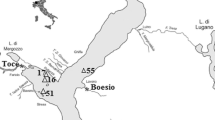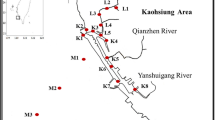Abstract
Sediments collected in 2004 from along the Detroit River (n = 19) and across all of Lake Erie (n = 18) were analyzed for isomers of the flame retardant chemical, hexabromocyclododecane (HBCD), using liquid chromatography-tandem mass spectrometry. Sediment samples had ΣHBCD concentrations ranging from not detected to 1.6 ng/g d.w. γ-HBCD (56 %–100 % of ΣHBCDs) was the predominate isomer, observed in 7 of 19 samples from the Detroit River and 6 of 18 samples from Lake Erie (all within the western basin). α-HBCD was found in 4 Detroit River and 2 Lake Erie western basin sites, while β-HBCD was only in two Detroit River samples. High ΣHBCD concentrations (>100 ng/g d.w.) were found in two sludge samples from two Windsor, ON, wastewater treatment plants that feed into the Detroit River upstream. HBCD contamination into the Detroit River is a major input vector into Lake Erie and with an apparent sediment dilution effect moving towards the eastern basin.


Similar content being viewed by others
References
Covaci A, Gerecke AC, Law RJ, Voorspoels S et al (2006) Hexabromocyclododecanes (HBCDs) in the environment and humans: a review. Environ Sci Technol 40:3679–3688
Harrad S, Abdallah MA, Rose NL, Turner SD et al (2009) Current-use brominated flame retardants in water, sediment, and fish from English lakes. Environ Sci Technol 43:9077–9083
Ilyas M, Sudaryanto A, Setiawan IE, Riyadi AS, Isobe T, Takahashi S et al (2011) Characterization of polychlorinated biphenyls and brominated flame retardants in sediments from riverine and coastal waters of Surabaya, Indonesia. Mar Pollut Bull 62:89–98
Klosterhaus SL, Stapleton HM, La Guardia MJ, Greig DJ (2012) Brominated and chlorinated flame retardants in San Francisco Bay sediments and wildlife. Environ Int 47:56–65
La Guardia MJ, Hale RC, Harvey E, Mainor TM, Ciparis S (2012) In situ accumulation of HBCD, PBDEs, and several alternative flame-retardants in the bivalve (Corbicula fluminea) and gastropod (Elimia proxima). Environ Sci Technol 46:5798–5805
Law K, Halldorson T, Danell R, Stern G, Gewurtz S, Alaee M, Marvin C, Whittle M, Tomy G (2006) Bioaccumulation and trophic transfer of some brominated flame retardants in a Lake Winnipeg (Canada) food web. Environ Toxicol Chem 25:2177–2186
Law RJ, Covaci A, Harrad S, Herzke D et al (2014) Levels and trends of PBDEs and HBCDs in the global environment: status at the end of 2012. Environ Int 65:147–158
Letcher RJ, Mattioli LC, Fernie KJ, Marteinson SC et al (2015) Uptake, distribution, depletion and in ovo transfer of isomers of hexabromocyclododecane flame retardant in diet exposed American kestrels (Falco sparverius). Environ Toxicol Chem (accepted)
Lu Z, Letcher RJ, Chu SG, et al (2015) Comparative spatial distribution of polychlorinated biphenyls, polybrominated diphenyl ethers, tetrabromobisphenol A and bisphenol A in the sediment of Lake Erie of the North American Great Lakes. J Great Lakes Res (submitted)
Marvin CH, Tomy GT, Alaee M, MacInnis G (2006) Distribution of hexabromocyclododecane in Detroit River suspended sediments. Chemosphere 64:268–275
Marvin CH, Tomy GT, Armitage JM, Arnot JA et al (2011) Hexabromocyclododecane: current understanding of chemistry, environmental fate and toxicology and implications for global management. Environ Sci Technol 45:8613–8623
Morris S, Allchin CR, Zegers BN, Haftka JJ, Boon JP et al (2004) Distribution and fate of HBCD and TBBPA brominated flame retardants in North Sea estuaries and aquatic food webs. Environ Sci Technol 38:5497–5504
Remberger M, Sternbeck J, Palm A, Kaj L et al (2004) The environmental occurrence of hexabromocyclododecane in Sweden. Chemosphere 54:9–21
Tomy GT, Budakowski W, Halldorson T et al (2004) Biomagnification of α- and γ-hexabromocyclododecane in a Lake Ontario food web. Environ Sci Technol 38:2298–2303
UNEP (2013) Recommendation by the POPs review committee (POPRC) to list hexabromocyclododecane in Annex A to the Stockholm convention and draft text of the proposed amendment. In: 6th Meeting, Conference of the Parties to the Stockholm Convention
Wu MH, Zhu JY, Tang L, Liu N, Peng BQ, Sun R, Xu G (2014) Hexabromocyclododecanes in surface sediments from Shanghai, China: spatial distribution, seasonal variation and diastereoisomer-specific profiles. Chemosphere 111:304–311
Xu J, Zhang Y, Guo C et al (2013) Levels and distribution of tetrabromobisphenol A and hexabromocyclododecane in Taihu Lake, China. Environ Toxicol Chem 32:2249–2255
Yang R, Wei H, Guo J, Li A (2012) Emerging brominated flame retardants in the sediment of the Great Lakes. Environ Sci Technol 46:3119–3126
Zhang Y, Ruan Y, Sun H, Zhao L, Gan Z (2013) Hexabromocyclododecanes in surface sediments and a sediment core from rivers and harbor in the northern Chinese city of Tianjin. Chemosphere 90:1610–1616
Acknowledgments
We thank all individuals and organizations in the US and Canada for the cooperative sampling of Lake Erie sediments at nearshore and offshore stations as part of the Lake Erie Collaborative Comprehensive Survey (ECCS), including those people at Environment Canada, Ontario Ministry of the Environment, Ontario Ministry of Natural Resources, and the USGS. The present study was supported by the Canada Research Chairs Program (R. J. Letcher and G. D. Haffner).
Author information
Authors and Affiliations
Corresponding author
Rights and permissions
About this article
Cite this article
Letcher, R.J., Lu, Z., Chu, S. et al. Hexabromocyclododecane Flame Retardant Isomers in Sediments from Detroit River and Lake Erie of the Laurentian Great Lakes of North America. Bull Environ Contam Toxicol 95, 31–36 (2015). https://doi.org/10.1007/s00128-015-1491-y
Received:
Accepted:
Published:
Issue Date:
DOI: https://doi.org/10.1007/s00128-015-1491-y




